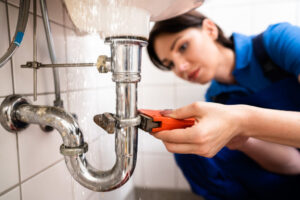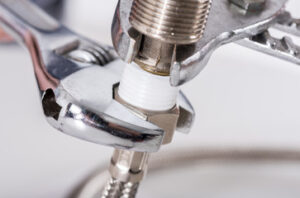Plumbers In Cleveland Ohio are tradespeople who install, repair, and maintain piping systems that carry water and sewage in commercial and residential buildings. They interpret blueprints and building codes to plan plumbing installations and use specialized tools to troubleshoot issues with existing pipes and fixtures.
Soft skills are important for this career, as is the ability to communicate with clients clearly and make recommendations that fit their needs. Take a career test to see if plumbing is a good fit for you.

The job duties of a plumber are to install, repair, and maintain plumbing systems and fixtures. They also inspect and test plumbing systems to ensure they comply with regulations. Some states require a license to work as a plumber, and most learn through apprenticeships that last four to five years and combine classroom instruction with on-the-job training.
The most common work for a plumber involves residential and commercial structures. They install plumbing and piping for water supply, waste management, and heating and cooling systems. They also troubleshoot plumbing issues and respond to customer calls. These jobs can involve fixing a toilet or addressing serious problems like sewer backups or flooding.
Plumbers may also specialize in certain types of projects or work environments. Commercial plumbers, for example, focus on water and waste removal systems for large businesses. They may work with extensive connections to the local water main and sewage system and often deal with more complex problems than their residential counterparts.
Plumbing technicians must be able to read and interpret blueprints to assess or plan plumbing installations and layouts. They must also be able to weld, cut, and assemble pipes, tubes, fittings, and fixtures. They must also be able to perform basic electrical work to control plumbing functions and devices.
A plumber must have excellent communication skills to explain technical information clearly. They must be able to listen to customers’ concerns and explain the various options. In addition, plumbing tasks often require physical strength and stamina to lift heavy objects and climb ladders or stairs.
Many plumbers are on-call for emergency maintenance, so they must be willing to work at odd hours, including weekends and evenings. They must also be able to travel between different sites when necessary. They usually work with a team of other professionals, such as electricians, handypersons, and caretakers. They may also collaborate with kitchen fitters, domestic appliance engineers, and gas service technicians. To maximize their earning potential, plumbers should be able to handle multiple tasks simultaneously and work well under pressure.
To become a plumber, it is necessary to have the right education and training. There are various ways to get the proper training for this job, such as taking a college course, an apprenticeship program, or completing work experience with a master plumber. After you have received the proper education and training, you must be licensed in your state or area of expertise.
While there are no specific high school courses specifically tailored to plumbing, you should take a variety of subjects and courses that will prepare you for the skilled trades. Math classes are important for plumbing, as is a background in science and physics. These subjects are useful for learning how to read blueprints and understand the mechanics of plumbing systems.
It is also beneficial to have strong communication skills. This is because plumbers must be able to explain issues to customers and help them find solutions. They also need to be able to work well in a team.
Most states require that aspiring plumbers undergo a certain amount of apprenticeship and educational hours to become licensed. The apprenticeship programs can last up to five years and provide on-the-job training and classroom instruction. This is a great way to learn the basics of the trade and see whether you want to pursue it.
A career as a plumber can be very rewarding, but it has challenges. For example, the field of plumbing is very dependent on the economy. Therefore, plumbers must keep abreast of economic trends and construction activities in their areas to plan accordingly. In addition, a plumber must be able to solve problems quickly and efficiently to meet client expectations.
Another challenge is finding the right equipment and tools for the job. In addition, plumbers need to be able to lift heavy tools and equipment. Additionally, a plumber must understand electrical wiring well, especially if they need to repair an electric system.
The working conditions of a plumber can vary from site to site. They may work on a construction site alongside other tradespeople or in a small workshop doing maintenance work on plumbing fixtures and appliances. A private company or independent contractor can also employ them. Plumbers can be expected to work standard business hours but may need to be on call for emergencies. They may need to travel between sites and may be required to work overtime at peak times.
The job’s physical demands can be high, with plumbers frequently bending and reaching into tight spaces and often needing to lift heavy objects. They may also be exposed to hazardous substances and must follow safety procedures to avoid illness and injury. Plumbers who specialize in sewage systems may also be exposed to potentially infectious diseases, such as hepatitis, cholera, typhoid, and parasites like leptospirosis and cryptosporidiosis.
A plumber’s job can be very stressful and tiring, especially if they are on call for emergencies. They are likely to work a lot of overtime, which can lead to burnout. In addition, the work is not for people who do not enjoy working with their hands or moving around all day.
Plumbers are usually required to wear personal protective equipment (PPE) when working with chemicals and sewage. They must follow their employer’s safe handling procedures and read their chemicals’ material safety data sheets. It is also important for them to take breaks regularly and to stay hydrated. They are also likely to be exposed to unpleasant smells and noise. They should also be aware of the potential hazards of working in hot water and be prepared for the risks of burns, cuts, and electrical shocks.
Some factors affect a plumber’s salary. These include region, experience level, and specialization. Plumbers working in high-demand areas earn more than those in less-populated regions. This is because there are more job opportunities and competition for skilled plumbers. Additionally, plumbers who provide emergency services are typically paid a premium for their expertise.
Plumbers can also advance their careers and increase their earning potential by becoming certified in certain fields. This includes earning certification as a Master Plumber. This requires further education and training, but it increases your marketability and allows you to charge higher rates for your services.
Some plumbers choose to run their own plumbing business. This career can be extremely lucrative but comes with additional responsibilities and costs. To maximize your earning potential, you should focus on networking and marketing your services to ensure you book jobs regularly. Additionally, you should invest in the best plumbing tools and software, as this will help you perform your work more efficiently and effectively.
The hours that you work as a plumber can also affect your salary. You may need to work overtime during peak seasons or for emergency jobs. This cannot be easy to manage if you try to maintain a balanced lifestyle outside of work. You should use a scheduling app such as Connecteam to manage your payroll and timesheets to keep your schedule in check.
You will likely work with a range of people as a plumber. These can include other tradespeople such as electricians, carpenters, and HVAC technicians. You may also need to interact with members of the public regularly, so you should ensure you are friendly and courteous.
Plumbers who can diversify their skills and offer various plumbing services often attract more customers and command higher salaries. This is because they can provide more value to their clients and are more likely to secure long-term contracts. For example, plumbers specializing in areas such as medical gas systems or sustainable plumbing solutions can often find themselves in high demand.



